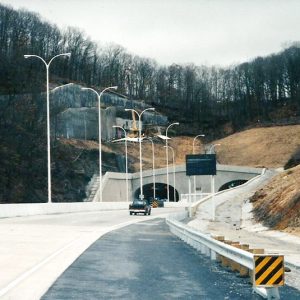calsfoundation@cals.org
Bobby Hopper Tunnel
Arkansas has seven railroad tunnels but only one highway tunnel. Named for the Arkansas Highway Commission director at the time of the tunnel’s construction, Bobby Hopper, the northwest Arkansas commission representative from Springdale (Washington County), the Bobby Hopper Tunnel is located on Interstate 49 in Washington County just north of the Crawford County line with its closest exit at Winslow (Washington County).
U.S. Highway 71, once classified by Reader’s Digest as “one of the most dangerous highways in America,” includes a perilous stretch between Alma (Crawford County) and Fayetteville (Washington County) through the Ozark Plateau. Thus, construction of an alternate route was designed to make the trip safer, as well as reduce travel time. Approved in 1987 and completed in 1999, at a cost of $458 million, the alternate route, eventually named Interstate 540 (and later renamed Interstate 49), had an obstacle of an unnamed 1,800-foot peak just north of the Washington–Crawford County line in what John Haman of Arkansas Business called “smack in the middle of motoring wilderness.” A tunnel feasibility study was awarded to GarverUSA (formerly Garver & Garver) of Little Rock (Pulaski County), which subcontracted with Sverdrup Corporation of Maryland Heights, Missouri, and TapanAm Associates, Inc., of Kansas City, Missouri, to determine the best option—a tunnel. The alternative would disfigure the topography and necessitate a 200-foot cut creating 8 million cubic yards of debris to be disposed of, as it was not usable within the project.
The contractor of Hoover Dam and the Golden Gate Bridge, J. F. Shea Company of Walnut, California, was awarded the contract to construct the tunnel. Bunyard Tunnel, as it was first named, since Bunyard Road (namesake for a Ford dealership) crossed there, was completed in 1998 at a cost of $37.1 million.
At an elevation of 1,640 feet above sea level, twin parallel tunnels were mined, not bored, through the mountain in a horseshoe contour since a circular shape, like that used in sewer or train projects, was not needed. Blasting, drilling, and excavation removed native shale and sandstone rocks, slowly chipping to the desired width and length. The hollowed-out channel was lined with reinforced concrete, as were both openings. The finished total length is 1,595.2 feet, with a width of thirty-eight feet and a height of twenty-five feet, as measured from the roadway to the top of the arch, allowing for two lanes of traffic and shoulder space on each portal. The tunnel has an inclined pitch in that southbound traffic ascends inside the tunnel while northbound traffic descends, with both at the same grade. Cross-passages occur every 265 feet allowing for five emergency ways in. Besides paved openings, the tunnel has traffic signals, lighting, message signs, carbon monoxide monitors, fire protection, and closed-circuit television systems to monitor traffic remotely at the Fort Smith (Sebastian County) highway department district headquarters. A state-of-the-art mechanical ventilation system to ensure air quality, only the third such system in the United States, was installed using longitudinal jet fans, as opposed to transverse ventilation, thereby reducing costs and maintenance. Uninterruptible power and a maintenance area are housed at the north entrance in an unmanned service building. A tunnel antenna system is included for AM, FM, UHF and VHF, and 800 MHz radiation.
Based on the culmination of the quality process and results, customer focus, teamwork, innovation, value, and long-term improvement, the Bobby Hopper Tunnel was awarded the 1999 National Quality Initiative Achievement Award for the state of Arkansas from the Federal Highway Administration.
For additional information:
Haman, John. “Work Still Continues on U.S. Highways 65 and 67.” Arkansas Business. August 24, 1998, pp. 28–29.
Tobler, Christopher. “Arkansas Tunneling to a Highway First in Northwest.” Arkansas Business. March 20, 1995, pp. 6–7.
U.S. Department of Transportation, Federal Highway Administration. “International Community Helps FHWA Improve Tunnels in U.S.” Research & Technology Transporter, May 2000, p. 1, 6. Online at http://www.fhwa.dot.gov/publications/transporter/00may/520000.pdf (accessed February 28, 2022).
———. Press Release, January 8, 1999, number DOT 02-99, U.S. Secretary of Transportation Rodney E. Slater dedication of I-540.
John Spurgeon
Bella Vista, Arkansas








Comments
No comments on this entry yet.